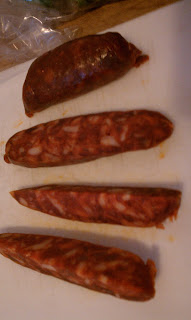Corn
My sister-in-law teases me for my 6 minute method but my corn always comes out perfect for my taste. Boil water. Add salt. Insert shucked ears of corn. Return to boil and time for 6 minutes. Remove, slather with butter and eat. Perfect every time.
Country Potatoes
What to do with leftover baked potatoes? Cut 'em into chunks. Heat a couple of tablespoons of butter and/or oil in a skillet over medium heat. Toss the chunks in the butter/oil to coat, season with salt, pepper and thyme, cook until brown and crusty. Turn the potato pieces and repeat the process until all sides are brown.
Pigs in Blankets
There are several sausage preparations called pigs in blankets and this is one of mine. Roll hot dogs up in corn tortillas and secure with a toothpick. Heat 1/4" of oil over high heat in a skillet. Cook hot dogs in oil, turning occasionally so that all sides are crisp. Remove to a draining rig and serve. I use an overturned cooling rack on paper towels. Serve with your favorite hot dog condiment but guacamole is awesome.
Pie Crust Cookies
This is a great food memory from my childhood. On pie baking day, cut the leftover trimmings of pie dough into cookie sized pieces. Sprinkle with sugar and cinnamon. Bake on a cookie sheet at 350°F until golden brown and delicious. What a treat!
Have a great weekend!
Shrimp13













































